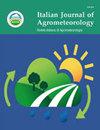Effects of heat waves on soil temperatures in Slovenia
IF 0.8
4区 农林科学
Q2 AGRONOMY
Italian Journal of Agrometeorology-Rivista Italiana Di Agrometeorologia
Pub Date : 2022-07-19
DOI:10.36253/ijam-1388
引用次数: 1
Abstract
Soil temperature regulates the rate of plant growth and tells us much about the climatic characteristics of a particular site. Climate variability and extremes need to be studied and there is a large gap in knowledge about soil temperature during heat waves. Agricultural land is highly dependent on heat waves, which are becoming longer, more intense and more frequent, and it is important to monitor soil temperatures in situ to understand their changes during heat waves. Therefore, the aim of this work was to investigate how soil temperatures change at different depths during and after heat waves. Average daily air and soil temperature data for the 25-year period 1992-2016 were evaluated at four agrometeorological stations in three climate zones in Slovenia and analyzed during heat waves determined according to the Slovenian definition. During the period 1992-2016, 53 (Lesce) to 76 (Ljubljana) heat waves were identified. Analysis of average air and soil temperatures before, during and after heat waves showed higher responsiveness of the upper part of the soils and an increase in the time lag between maximum air temperature and maximum soil temperature with depth. The maximum temperature during the heat wave was reached on average in three to nine days, depending on the depth. Only in Moderate climate of the hilly region, the average daily temperatures at a depth of 100 cm remained below 20°C during and after the heat wave. The temperature rise in the deeper layers of the soil lasts longer than in the shallower layers.热浪对斯洛文尼亚土壤温度的影响
土壤温度调节着植物的生长速度,并告诉我们一个特定地点的气候特征。需要对气候变率和极端事件进行研究,而且在热浪期间的土壤温度知识方面存在很大差距。农业用地高度依赖热浪,热浪变得越来越长、越来越强烈、越来越频繁,监测土壤温度对了解热浪期间土壤温度的变化非常重要。因此,这项工作的目的是研究在热浪期间和之后不同深度的土壤温度是如何变化的。在斯洛文尼亚三个气候带的四个农业气象站评估了1992-2016年25年间的平均每日空气和土壤温度数据,并在根据斯洛文尼亚定义确定的热浪期间进行了分析。1992年至2016年期间,共发现53次(莱斯)至76次(卢布尔雅那)热浪。热浪发生前、期间和之后的平均空气和土壤温度分析表明,上部土壤的响应性更高,最高空气温度和最高土壤温度之间的时间差随着深度的增加而增加。热浪期间的最高温度平均在3至9天内达到,具体时间取决于深度。只有在温和气候的丘陵地区,在热浪期间和之后,100 cm深度的日平均温度保持在20°C以下。深层土壤的温度上升比浅层土壤的温度上升持续的时间更长。
本文章由计算机程序翻译,如有差异,请以英文原文为准。
求助全文
约1分钟内获得全文
求助全文
来源期刊

Italian Journal of Agrometeorology-Rivista Italiana Di Agrometeorologia
AGRONOMY-ENVIRONMENTAL SCIENCES
CiteScore
2.10
自引率
8.30%
发文量
6
期刊介绍:
Among the areas of specific interest of the journal there are: ecophysiology; phenology; plant growth, quality and quantity of production; plant pathology; entomology; welfare conditions of livestocks; soil physics and hydrology; micrometeorology; modeling, simulation and forecasting; remote sensing; territorial planning; geographical information systems and spatialization techniques; instrumentation to measure physical and biological quantities; data validation techniques, agroclimatology; agriculture scientific dissemination; support services for farmers.
 求助内容:
求助内容: 应助结果提醒方式:
应助结果提醒方式:


